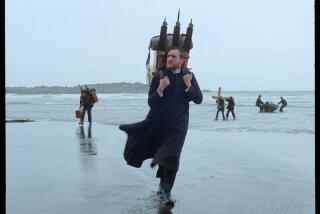The man who brought Iceland in from the cold
The Great Weaver From Kashmir
A Novel
Halldor Laxness
Translated from the Icelandic by Philip Roughton
Archipelago Books: 446 pp., $26
Americans are sometimes not too sure where or what Iceland is, but for the literary, it is a sort of holy land -- a small population (300,000 for the whole country), a harsh and obscure geography on the edge of the Arctic, that has nevertheless produced a major European literature for a thousand years. An argument might be made that only the language (old Norse, craggy and wildly inflected) and the literature have kept the country alive -- and mostly independent -- for a millennium.
But one difficulty in owning this distinguished literary ancestry is that your writers go on forever imitating the glories of the Middle Ages, neglecting the world around them -- the modern, whether language, style or subject. So it was in Iceland in 1900. Nobel Prize-winning novelist Halldor Laxness was born there on a farm outside Reykjavik in 1902 and lived so long (until 1998) that his life encompassed the entire 20th century. He did his best to get “the whole catastrophe,” as Zorba the Greek says, into more than 60 books -- from 1919 until almost the end. “The Great Weaver From Kashmir” was the young Laxness’ bulldozer to clear the first road into the 20th century. Icelandic writers assure me that whatever foreigners might think of this fascinating but shaggy beast of a book, they understand that it made modern literature possible in Iceland. You could now write past the Sagas, whatever their noble history.
After a long disappearance from print in English, Laxness is back in force on American bookstore shelves. “Independent People,” his most famous work, reappeared in 1997 after a 41-year absence, followed in this decade by six more major novels and now a seventh: “The Great Weaver From Kashmir,” published in 1927 but Englished now for the first time by Philip Roughton. Readers can see what he was like as a young writer before he quite became the Nobel genius. The seeds of Laxness’ style, his view of the world, his irony, his humor -- and his power to wring the heart -- are all there, but like bird chicks, they’ve not quite assumed their full adult feathers, their size or their grown-up wisdom.
Readers afraid of “hard” names (as in Dostoevski) had better get used to jawbreakers like Steinn Ellioi Grimulfsson, the boyish Byronic hero of this romance, and Dilja (the “a” is pronounced “ow”) Thorsteinsdottir and her doomed husband Ornolfur Ellioasson, the fish magnate. For this book is, before anything else, a romance: boy and girl inseparable since childhood, girl first neglected, then rejected, not for a lover but for the Catholic Church and for vaulting intellectual ambition: “I’ve made a pact with the Lord about becoming the most perfect man on earth . . . remade so that I might compose perfect poems on the beauty of God. . . . I am the Great Weaver from Kashmir.” Well, then. “I think you might have lost your marbles,” says Dilja. The reader will be inclined to agree, though their strained love and conversation continue frothing for 400 pages.
Laxness makes a duke’s mixture of styles and techniques to pursue his narrative. The book begins with straightforward third-person narrative, proceeds with an exchange of letters, then a picaresque travel narrative with shifting voices and points of view, then dream sequences and more. On a train trip through Europe, Steinn, our hero, meets a priest who is the canon of a Benedictine Abbey. Steinn lectures him at length (even on sexuality!), and the smart old priest just listens, lets him babble on about Nietzsche, Strindberg, Croce, Freud and myriad others -- in other words, the generative ideas of 20th century fiction and thought. Laxness gives us the excitement of a smart young fellow of 23 trying his chops, seeing what can be done that’s new in an old language.
“The Great Weaver” is not a prudent book: It contains little of the combination of tenderness and irony that distinguishes the major Laxness and, unless I miss it in the translation, little of Laxness’ continual humor. Even at his most tragic, he is always a very funny writer in his later writing -- but the young don’t seem to find themselves comfortable as objects of humor. “The Great Weaver” generates great excitement (a kind of breathless speed) that reminds me of the mad energy of “On the Road,” though I doubt Laxness typed “The Great Weaver” on a single scroll. Laxness confessed, in a 1948 edition, that his book’s “main fault is that it was never rewritten.” He called it “children’s literature” from an energetic boy of 23.
It is most curious to see the working of a genius’ mind in the process of formation, selecting this, rejecting that, as if this book were a blueprint for “The Origin of Species.” At least two scenes of unquestioned narrative power are here as well. Ornolfur, the older, rich businessman guardian, is eaten by his secret love for Dilja and his contempt for the arrogant poet Steinn, his nephew. He finally confesses his love in a dramatic scene with more than a little Strindberg in it: He proposes to her in an awkward, halting, but oddly business-like manner. As if she has given up, she finally accepts. The marriage is a disaster.
Iceland at the time of Laxness’ birth remained sunk in its hundreds of years of medieval poverty and isolation. By 1920, when the young Halldor set off on his European adventures, a new native middle class had begun to emerge, a class that traveled abroad, lived in wood or concrete, not mud houses, and had begun to amass modest fortunes. Though Laxness was not born part of this new class, he adopted them as his stable of characters in “The Great Weaver.” They are self-consciously respectable, even fashionable, proud of themselves for accumulating, looking abroad for manners and machines -- the car has arrived, as much a symbol as transport (as it still mostly is). Steinn, the “hero,” does his best to drop out of this class, intellectually at least, just as Laxness himself did in his embrace of scandalous notions like Benedictine monasticism and Bolshevism.
“The Great Weaver” is, in this way, a sort of Icelandic “The Great Gatsby” in reverse: Jimmie Gatz, North Dakota farm boy, goes to the city to get rich and pursue his romantic vision of Daisy -- Steinn, however, falls in love with the Virgin Mary and poverty to escape his middle-class roots. Same story in reverse?
Laxness’ books took an interesting turn after “The Great Weaver”: He went to the bottom of Iceland for his heroes (to the most benighted poor and powerless) -- to Salka Valka, an orphan girl in a bleak Westfjords fishing village, and to Bjartur, the poorest farmer in Iceland, swindled by his rich masters. Laxness discovered his true heart as a writer, like Flannery O’Connor did in rural Georgia, among the poor and humiliated.
When Laxness died at 95, Icelanders found with amazement that their great man -- Halldor the commie, the skeptic, the cynic -- had never rejected his conversion in a Benedictine monastery in Luxembourg in 1923. He demanded burial out of Landakot, the Catholic cathedral in Reykjavik. And so Laxness was sung to his grave with a proper High Mass. Icelanders accused him of irony, one last joke.
No reader of Book Six of “The Great Weaver” should have any doubt of the genuineness of Laxness’ spiritual experience. Icelandic scholars, investigating this, found the section completely autobiographical, including a meticulously accurate description of the ancient abbey itself, unchanged 80 years after Laxness’ oblate vows. This magnificent piece of writing, well-translated by Roughton, is the crown jewel in this slightly ungroomed chaos of a novel. Readers, however, should be patient and remember what they were like at 20 when the world seemed their oyster and they saw the green light at the end of the dock.
More to Read
Sign up for our Book Club newsletter
Get the latest news, events and more from the Los Angeles Times Book Club, and help us get L.A. reading and talking.
You may occasionally receive promotional content from the Los Angeles Times.






